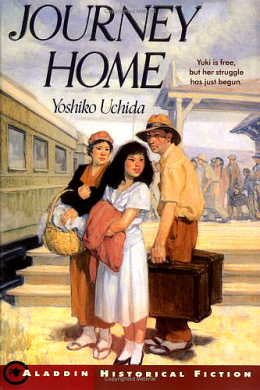Journey Home (book)
| Title | Journey Home |
|---|---|
| Author | Yoshiko Uchida |
| Illustrator | Charles Robinson |
| Original Publication Date | 1978 |
| Pages | 131 |
| Awards | International Reading Association Children's Choice, 1979 |
| WorldCat Link | https://www.worldcat.org/title/journey-home/oclc/4334673/ |
Novel for young adults about a Japanese American family leaving the concentration camps and eventually returning to their home by prolific author Yoshiko Uchida, written as a sequel her 1971 book Journey to Topaz .
As in Journey to Topaz , the protagonist is Yuki Sakane, a twelve year old girl who was incarcerated with her parents at the Topaz , Utah, concentration camp. As the book begins, the family is leaving the camp for Salt Lake City, Utah, since they are still prohibited from returning to their Berkeley home. In Utah, her mother works as a cleaning lady for a family with eight children, and her father gets a job as a shipping clerk. Their landlord, Mrs. Henley, is openly racist and questions the loyalties of Japanese Americans; despite this, she eventually becomes friendly to the family. When Japanese Americans are allowed to return to the West Coast at the beginning of 1945, the Sakanes head back to the Bay Area, staying initially in an Oakland hostel . They find their old home occupied, their yard unkempt, and that vandals had hit their old temple and the Japanese cemetery. Pooling their funds with two friends, they purchase a store one of them had owned before the war. (Forced to sell it for a mere $400, the group have to pay $5,000 to buy it back.) Upon their purchasing it, someone sets fire to it. Just then, Yuki's brother, Ken, returns to the family from the hospital, where he had been recovering from wounds suffered as a member of the 442nd Regimental Combat Team . Their spirits are restored when their neighbors, the Olssens, offer them breakfast and help to rebuild the store; the Sakanes are shocked when they learn that the Olssens' son had been killed fighting on Iwo Jima.
As in the first book, the events are loosely based on Uchida's own experiences during the war. She also works in many broader historical aspects of the resettlement period, ranging from the difficulties returnees faced with jobs and housing to the discrimination and occasional vandalism they encountered. She also includes some specific historical events, including the killing of James Hatsuki Wakasa at Topaz by guards (the grandfather of one of Yuki's friends is killed in a similar fashion) and the heroism of Sadao Munemori (like Munemori, Ken's best friend dives on a grenade to save the live of fellow soldiers).
Though Uchida wrote a third book of fiction set in the concentration camps ( The Bracelet , 1993), she never revisited this set of characters again. Initially published by Atheneum in 1978, it was republished by Houghton Mifflin in 1989, Aladdin books in 1992, and Prentice Hall in 2000, all with illustrations by Charles Robinson.
Find in the Digital Library of Japanese American Incarceration
This item has been made freely available in the Digital Library of Japanese American Incarceration , a collaborative project with Internet Archive .
For More Information
Harada, Violet H. “Caught Between Two Worlds: Themes of Family, Community, and Ethnic Identity in Yoshiko Uchida’s Works for Children.” Children’s Literature in Education 29.1 (Mar. 1998): 19–30.
Inagawa, Machiko. "Japanese American Experiences in Internment Camps during World War II as Represented by Children's and Adolescent Literature." Ph.D. dissertation, University of Arizona, 2007.
McDiffett, Danton. "Prejudice and Pride: Japanese Americans in the Young Adult Novels of Yoshiko Uchida." The English Journal 90.3 (Jan. 2001): 60–65.
Last updated June 5, 2020, 3:40 p.m..

 Media
Media